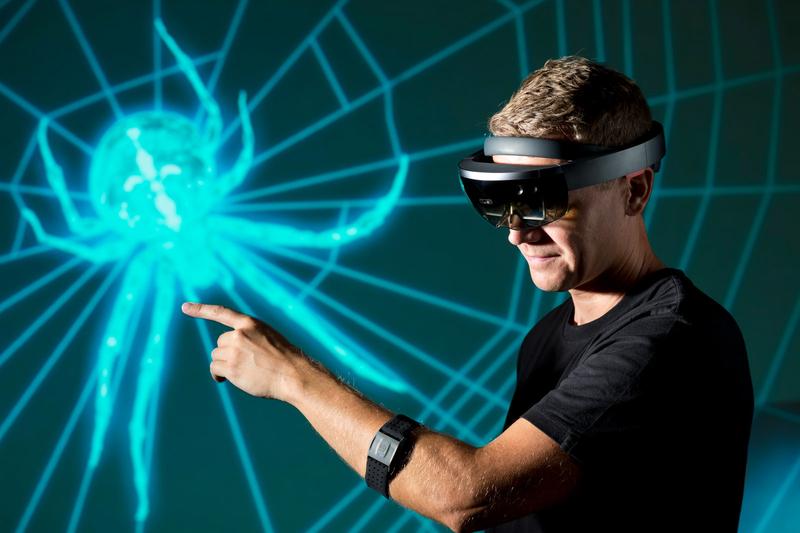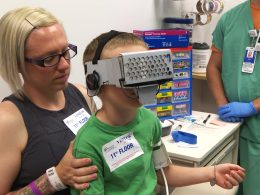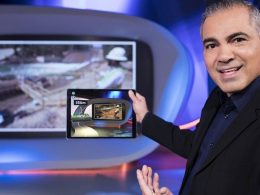Arachnophobia is what experts call the fear of spiders. Together with partners, Fraunhofer researchers are developing a digital therapy system that will enable treatment in the home environment using AR and give those affected a better sense of security. A demonstrator of the system will be on display from 12 to 15 November at the Medica in Düsseldorf.
Around 3.5 to 6.1 per cent of the population suffer from this: Fear of spiders. Until now, this phobia has been treated with the help of confrontation therapy. The problem: 60 to 80 per cent of spider phobics are not even treated due to the lack of treatment available. There are no spiders in this country that are dangerous to humans. Nevertheless, many people panic at the sight of these eight-legged creatures. Their body reacts with palpitations, trembling, dizziness, sweating or shortness of breath.
In the "DigiPhobia" project, researchers from the Fraunhofer Institute for Biomedical Engineering IBMT are working with Promotion Software GmbH, Saarland University and Saarland University Hospital to counteract these problems. They are developing a new type of digital therapy system that will enable exposure therapy in the home environment.
The confrontation with the anxiety-inducing object in virtual reality is intended to make it easier for patients to face up to their fears and lower the inhibition threshold for starting treatment. The system consists of a digital therapy environment, wearable sensors and data goggles, more precisely augmented reality goggles.
Confrontation therapy in virtual reality
"We transfer the real confrontation therapy into the digital game system that runs on the data glasses. All exercises are mapped digitally. The phobic person can solve the various tasks, such as catching a spider with a glass and a postcard or poking the crawling animal in virtual reality," says Dr Frank Ihmig, scientist at the Fraunhofer IBMT, describing the therapeutic approach.
Ihmig and his team are realising the therapy management software and the biofeedback control system. This consists of wearable sensors that measure the patient's vital parameters such as heart rate variability, skin conductivity and respiratory rate during a session.
Calculate physiological fear response with machine learning algorithm
Features that represent emotional stress can be extracted from the measured parameters. The researchers use these stress characteristics to train a machine learning algorithm. "We use the learning algorithm to derive the patient's physiological anxiety response and try to determine the intensity of the anxiety. In addition to the subjective perception of the spider phobic, this provides an objective measure of their fear response.
This calculated measurement is fed back into the digital game. This allows us to personalise the therapy to the patient's needs," says Ihmig, explaining how the innovative treatment works. Game elements such as the size, number and distance of the spiders, as well as the movement behaviour of the eight-legged creatures, can be dynamically adjusted.
The Fraunhofer researchers use adhesive electrodes to measure the ECG and skin conductivity, while breathing is monitored using a chest strap with a piezo sensor. The measured signals are transmitted wirelessly via Bluetooth to the therapy management software. All session data and the course of therapy are archived in the database and made available to therapists and clinical researchers for analysis.
Efficacy to be determined in clinical trial
A validation study will start in spring 2019 to evaluate the effectiveness of the digital therapy. Similar approaches using virtual reality (VR) glasses have shown that this form of therapy can achieve good results. The results of the analyses should lay the foundation for further treatment concepts. It is conceivable, for example, that the therapy could be transferred to other phobias such as the fear of snakes or cockroaches. "We hope that the results of the clinical study will open up new perspectives for the treatment of patients suffering from specific phobias," says the researcher.
The results also form the basis for the development of a system case that contains the complete therapy set. "The long-term goal is for patients to be able to borrow the case from doctors' surgeries or medical supply stores and carry out individual sessions and exercises at home," says Ihmig. The researcher and his team will be presenting the biofeedback system from 12 to 15 November at the Medica trade fair in Düsseldorf at the joint Fraunhofer stand in Hall 10, Stand G05/H04.
Source: PM Fraunhofer Institute









